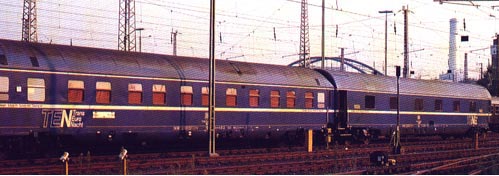| |
Sleeping coaches
WLABC4üm-54/WLAB4ümg-54/WLABüm 173
WLAB4ümg-59/WLABm 174
WLABümh-67/WLABmh 175
WLABsm 166
WLABC4üm-54/WLAB4ümg-54/WLABüm 173
In 1954 for the first time there were new post war sleeping coaches built. The coaches WLABCüm-54 were prototype coaches and were built in a serie of 10 coaches. These coaches were initially equiped with the old coach corridors but these were later replaced by the modern corridors. The indication was then changed to WLABC4ümg-54. After 1966 the indication was changed to WLABüm 173. In 1984 all 10 coaches were sold to HUPAC.
| Aanduiding: |
WLABC4üm-54/WLAB4ümg-54 tot '66
WLABüm-173 vanaf '66 |
| Aantal gebouwd: |
10 |
| Bouwjaar: |
1954 |
| Gewicht: |
- |
| Asstand: |
2.500 mm |
| Lengte: |
26,4 m |
| Afstand tussen draaistel punten: |
19 m |
| Breedte: |
2,825 m |
| Hoogte: |
4,05 m |
| Draaistellen: |
- |
| Maximum toegelaten snelheid: |
- |
WLAB4ümg-59/WLABm 174
Between 1959 and 1969 the DSG (Deutsche Schlafwagen Gesellschaft) ordered 77 sleeping coaches WLAB4ümg-59, from 1966 indicated as WLABm 174. These sleeping coaches, also indicated as type "Universal" had 33 sleeping places. The coaches were built of steel St 37 and were built by Hansa. The first 40 coaches had bogies of type Minden-Kassel and the other 37 coaches had bogies MD 33.
To offer enough headroom in the compartments with three beds, the roofs of the coaches were higher than the other express train coaches of type "m", the roofs were 4250 mm. Each coach had 11 compartments, each 1700 mm width with each 3 seats. Each compartment had a removable sidewall from which you could make one big compartment out of two compartments. The two top beds could be folded up and the lowest bed could be folded down to three seats.
Each coach was provided with a staff compartment. The coach had all a climat control system of type Luwa-Jettair with a stationary heating installation. Characteristic are the six big windows on one side of the coach. In 1973 all coaches were taken over by the DB and were running in the TEN (Trans Euro Nacht) pool of coaches.
 | | Sleepingcoaches of type Universal, coach at the left is WLABm 174 and the coach at the right is WLABmh 175 |
| Aanduiding: |
WLAB4ümg-59 tot '66
WLABm 174 vanaf '66 |
| Aantal gebouwd: |
77 |
| Bouwjaar: |
1959/69 |
| Gewicht: |
- |
| Asstand: |
2.500 mm |
| Lengte: |
26,4 m |
| Afstand tussen draaistel punten: |
19 m |
| Breedte: |
2,825 m |
| Hoogte: |
4.250 mm |
| Draaistellen: |
40 rijtuigen München-Kassel
37 rijtuigen MD 33 |
| Maximum toegelaten snelheid: |
140 km/h |
WLABümh-67/WLABmh 175
The second serie of sleeping coaches type "Universal" which were ordered by the DSG were 75 coaches of type WLABümh-67, from 1966 indicated as WLABmh 175. The coaches were built between 1968 and 1973. The coaches were built by O & K and had a maximum speed of 160 km/h. The coaches of the second serie differed on some points from the first serie. For example the roof ends are steeper than the roof ends of the first serie, and the coaches had now disc brakes, the toilets/washing rooms had now a shower.
| Aanduiding: |
WLABümh-67 tot '66
WLABmh 175 vanaf '66 |
| Aantal gebouwd: |
75 |
| Bouwjaar: |
1953/55 |
| Gewicht: |
- |
| Asstand: |
2.500 mm |
| Lengte: |
26,4 m |
| Afstand tussen draaistel punten: |
19 m |
| Breedte: |
2,825 m |
| Hoogte: |
4.250 mm |
| Draaistellen: |
MD 33 |
| Maximum toegelaten snelheid: |
160 km/h |
WLABsm 166
The sleeping coaches of type WLABsm 166 were bought with help of the financing company Eurofima. In 1975 63 sleeping coaches of type T2S were built by the "Schweizer Waggon- und Aufzügefabrik AG Schlieren-Zürich". The coaches were built for the railway companies DB, DSB, FS, NS, ÖBB and the SBB. Technically the coaches were derived from Swiss express train coaches from the sixties. 16 coaches were ordered by the DB.
The coaches were equiped with bogies MD 36 and with Oerlikon brakes. The coaches got the indication WLABsm 166 where the little "s" (Special) stood for the fact that there were also single sleeping compartmens. The coaches had 17 compartments, each 1223 mm width. Through a door between each two compartments, they could make from two compartmens one big compartment. On one coach end were no entrance doors, here was a staff compartment and two toilets.
| Indication: |
WLABsm 166 |
| Total build: |
16 |
| Year of construction: |
1975 |
| Weight: |
- |
| Gauge: |
2.500 mm |
| Length: |
26,4 m |
| Distance between bogie points: |
19 m |
| Width: |
2,825 m |
| Height: |
4.250 mm |
| Bogies: |
MD 36 |
| Maximum permitted speed: |
- |
|
